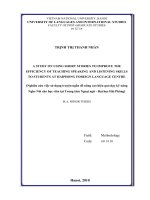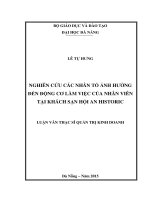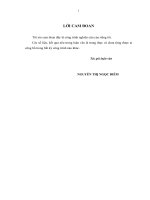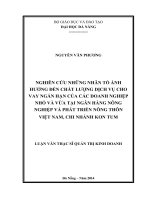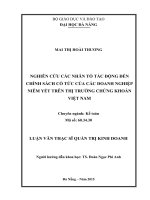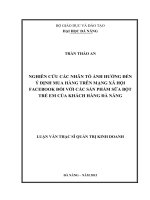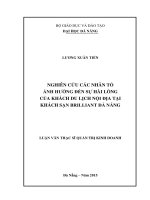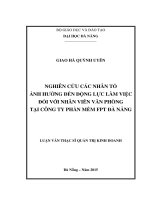(Luận văn thạc sĩ) a study on using short stories to improve the effeciency of teaching speaking and listening skills to students at haiphong foreign language centre
Bạn đang xem bản rút gọn của tài liệu. Xem và tải ngay bản đầy đủ của tài liệu tại đây (1015.95 KB, 48 trang )
VIETNAM NATIONAL UNIVERSITY, HANOI
UNIVERSITY OF LANGUAGES AND INTERNATIONAL STUDIES
FACULTY OF POST-GRADUATE STUDIES
TRỊNH THỊ THANH NHÀN
A STUDY ON USING SHORT STORIES TO IMPROVE THE
EFFICIENCY OF TEACHING SPEAKING AND LISTENING SKILLS
TO STUDENTS AT HAIPHONG FOREIGN LANGUAGE CENTRE
(Nghiên cứu việc sử dụng truyện ngắn để nâng cao hiệu quả dạy kỹ năng
Nghe Nói cho học viên tại Trung tâm Ngoại ngữ - Đại học Hải Phòng)
M.A. MINOR THESIS
Field:
Methodology
Code:
60 14 10
Hanoi, 2010
VIETNAM NATIONAL UNIVERSITY, HANOI
UNIVERSITY OF LANGUAGES AND INTERNATIONAL STUDIES
FACULTY OF POST-GRADUATE STUDIES
TRỊNH THỊ THANH NHÀN
A STUDY ON USING SHORT STORIES TO IMPROVE THE
EFFICIENCY OF TEACHING SPEAKING AND LISTENING SKILLS
TO STUDENTS AT HAIPHONG FOREIGN LANGUAGE CENTRE
(Nghiên cứu việc sử dụng truyện ngắn để nâng cao hiệu quả dạy kỹ năng
Nghe Nói cho học viên tại Trung tâm Ngoại ngữ - Đại học Hải Phòng)
M.A. MINOR THESIS
Field:
Methodology
Code:
60 14 10
Supervisor: Nguyễn Thúy Hương, M.A.
Hanoi, 2010
ii
TABLE OF CONTENTS
Page
Acknowledgements ......................................................................................
i
Table of contents .........................................................................................
ii
PART 1: INTRODUCTION.......................................................................
1
1. Background to the study ......................................................................................
1
2. Aims of the study .................................................................................................
2
3. Scope of the study ................................................................................................
3
4. Research questions ...............................................................................................
3
5. Methods of the study............................................................................................
3
6. Design of the study ..............................................................................................
3
PART 2: DEVELOPMENT .......................................................................
5
CHAPTER 1: LITERATURE REVIEW ..................................................
5
1.1. Speaking and Listening in foreign language learning ......................................
5
1.1.1. Speaking skill in foreign language teaching ..................................................
5
1.1.2. Listening skill in foreign language teaching ..................................................
6
1.2. Literature in language teaching.........................................................................
7
2.2.1. Concept of Literature .....................................................................................
7
1.2.1.1. Definitions ..................................................................................................
7
1.2.1.2. Genres .........................................................................................................
8
Concept of short stories ..............................................................................
8
1.2.2. Short stories in language teaching .................................................................
9
1.2.2.1. Advantages of short stories in teaching language skills .............................
9
1.2.2.2. How to choose short stories in teaching language skills ............................
13
iii
1.3. Summary ...........................................................................................................
16
CHAPTER 2: METHODOLOGY .............................................................
17
2.1. Subjects of the study .........................................................................................
17
2.2. Data collection instruments .............................................................................
17
2.2.1. Questionnaire 1 ..............................................................................................
17
2.2.2. Questionnaire 2 ..............................................................................................
18
2.3. Procedures .........................................................................................................
18
CHAPTER 3: RESULTS AND DISCUSSION ........................................
20
3.1. Results and Discussion .....................................................................................
20
3.1.1. Results from the first questionnaire ...............................................................
20
3.1.2. Description of the application of short stories in the eight weeks .................
25
3.1.3. Results from the second questionnaire ..........................................................
25
3.2. Findings ............................................................................................................
30
3.3. Summary ...........................................................................................................
31
CHAPTER 4: RECOMMENDATIONS ...................................................
32
4.1. Suggested activities for using short stories
in teaching listening and speaking skills..................................................................
32
4.1.1. Suggested activities........................................................................................
32
4.1.2. Sample lesson plans .......................................................................................
33
PART 3: CONCLUSION ...........................................................................
36
1. Suggestions for further study ...............................................................................
36
2. Conclusion ...........................................................................................................
36
REFERENCES ............................................................................................
38
LIST OF FIGURES AND TABLES
List of figures
Page
Figure 1. Students’ enjoyment in reading short stories ..................................................
20
Figure 2. Students’ preference in terms of the length of a short story ...........................
21
Figure 3. Students’ favourite topics ...............................................................................
22
Figure 4. Reasons why students do not like reading short stories .................................
24
Figure 5. Activities in the pre-stage ...............................................................................
26
Figure 6. Students’ activities when reading a short story ..............................................
27
Figure 7. Activities in the post-stage .............................................................................
28
Figure 8. Students’ participation in the class activities..................................................
29
Figure 9. Benefits students gain from the lesson using short stories .............................
30
List of tables
Table 1. Students’ difficulties in dealing with a short story ..........................................
23
1
PART 1: INTRODUCTION
This part gives an introduction to the study, including the background to the study,
the aims, the scope, the research questions and the methods as well as the design of the
study.
1. Background to the study
Haiphong Foreign Language Centre is one of the biggest and most prestigious
language centres in Haiphong, with well-qualified and enthusiastic teachers. The number
of English teachers at this centre is 68 (15 male teachers and 53 female teachers) including
24 full-time teachers and 44 part-time teachers. Most teachers at Haiphong Foreign
Language Centre graduated from universities such as Vietnam University of Languages
and International Studies, Vietnam National University, Hanoi, Hanoi University,
Haiphong University and Haiphong Private University, etc. A half of the teachers have
less-than-5-year teaching experience. They are very eager to access new teaching methods
and apply those methods in teaching practice.
Every month a professional meeting is held at the centre, so that teachers can
discuss problems and exchange ideas. They are all eager to apply initiatives in teaching,
and ready to welcome new ideas.
At Haiphong Foreign Language Centre there are classes for students of three levels:
Elementary, Pre-intermediate and Intermediate. Each level consists of two courses, each
lasting from three to five months. The main course books in use are Streamlines English –
Departures, Connections and Destinations (by Bernard Hartley and Peter Viney, 1982).
Recently, „Headway‟, „Lifelines‟ textbooks were made use of to improve students‟
listening and speaking skills. Besides, supplementary materials like „Facts and Figures‟,
„Cause and Effect‟, „Let‟s talk‟, „Listen carefully‟, are also used by the teachers.
Students at Haiphong Foreign Language Centre are of all ages and walks of life,
including university or college students, school-children. The others are in-service learners.
Their purposes of learning and language levels are quite different. The major purposes of
learning English of learners are for their studies and their jobs. Some of them learn English
for fun, but this is not common. In general, they are hardworking and very involved in the
learning process. As most of them are young learners, they learn very quickly and make a
2
lot of progress. Some learners, who are at the age of 40 to 50 and over, have difficulties in
learning because of many reasons (busy with work or family, limited ability, etc.)
The majority of learners come to the centre with the hope of achieving a good
command of English. They consider the four skills of listening, speaking, reading and
writing very important, but speaking and listening are given the top priority as these two
skills can help them achieve their goals of learning and working. Good listening and
speaking skills can help university and/ or college students pass oral examinations at
University or College easily, and those who work with foreign partners wish to use English
effectively to negotiate and gain contracts as well as attract investment from foreign
companies.
Being aware of the importance of teaching speaking and listening skills to students,
the writer often asks herself, “How can we improve students‟ speaking and listening
skills?” and “Could there be any other material to help encourage students‟ involvement in
speaking and listening lessons?” The idea of using short stories as supplementary materials
came to her when she read the M.A thesis of Nguyen Thi Ngoc Tu, “A study on using
short stories to improve the efficiency of teaching English to the first year students at
Vietnam Maritime University” (2005).
Encouraged by what Nguyen had achieved, the writer decided to conduct “A study
on using short stories to improve the efficiency of teaching speaking and listening skills to
students at Haiphong Foreign Language Centre”.
2. Aims of the study
The study aims at:
- Investigating the students‟ attitude towards the use of short stories in language
learning
- Finding out how short stories improve the efficiency of teaching speaking and
listening skills to students at Haiphong Foreign Language Centre
- Giving some suggestions on using short stories in the speaking and listening
lessons.
3. Scope of the study
3
In this minor thesis the writer intends to deal with the question of how short stories
help improve the efficiency of teaching speaking and listening skills, in which speaking
skill is paid more attention and listening skill is considered the integrating skill. The stories
used in the research are two or three pages long only, with simple contents, of a variety of
topics according to the students‟ preference such as love, friendship, schools, etc.
4. Research questions
This paper is carried out in order to answer the following questions.
Question 1: What are the attitudes of students at Haiphong Foreign Language
Centre towards the use of short stories in language teaching?
Question 2: Can applying short stories help improve the efficiency of teaching
speaking and listening skills at Haiphong Foreign Language Centre?
5. Methods of the study
The quantitative method is used in this paper. The data collected are from the
intermediate students at Haiphong Foreign Language Centre. Survey questionnaires are
used to collect data and evidences for the paper, and then data are analyzed quantitatively.
There are two questionnaires for students. The first questionnaire consists of 5
questions, the aims of which are to find out the students‟ preference of types of short
stories and their attitude toward the use of short stories in foreign language learning.
The second questionnaire includes 5 questions, which aim at investigating the
effects of short stories in teaching listening and speaking skills.
6. Design of the study
This paper is organized into three parts. Each part deals with an important aspect of
the study.
Part 1 presents overview introduction of the study that includes the background of
the study, the aims, the scope, the research questions and the method as well as the design
of the study.
Part 2 consists of four chapters.
Chapter 1 reviews some theoretical issues relevant to the study in two main parts:
Speaking and listening in foreign language learning and Literature in language teaching.
4
Chapter 2 gives a profile of the subjects of the study as well as description of data
collection instruments and research procedures.
Chapter 3 presents the data analysis and findings.
Chapter 4 discusses some suggested techniques for using short stories in teaching
speaking and listening skills.
Part 3 points out the limitations of the study and gives conclusion to the study.
5
PART 2: DEVELOPMENT
CHAPTER 1: LITERATURE REVIEW
In this chapter, the theoretical background to the study, including the theories on
speaking and listening in foreign language teaching and theories on literature in language
teaching, with a focus on short stories, is reviewed.
1.1. Speaking and Listening in foreign language teaching
1.1.1. Speaking skill in foreign language teaching
For the purpose of analysis and instruction, language has been divided into different
skill areas. These can be discussed in the framework of how we learn our first language. A
child first learns to practice language by speaking, combined with listening. Then, when
school begins, children learn by the skills of reading and writing. As learners grow in their
language ability and use, the different skills are most often integrated with each other so
that they are being in used in coordination with each other. In conversation, when one
person is the speaker, another is the listener. After listening and understanding, the hearer
responds by speaking. Just think of all the different conversations you have in one day and
compare that with how much written communication you do in one way. Which do you do
more of? Of course, in our daily lives, most of us speak more than we write.
In academic setting, while students are listening, they may also be writing notes or
reading a handout. As a teacher, you will be reading your lesson plans and then speaking to
your students. We can see that, in order to show that you understand anything, you have to
speak it out. Therefore, Lawtie (2004) affirmed, “Speaking is fundamental to human
communication.” (cited in Nguyen Thi Le Thuy, 2008).
In Florez (1999), speaking is “an interactive process of constructing meaning that
involves producing and receiving and processing information”. It is often spontaneous,
open-ended, and evolving.” (cited in Le Van Canh‟s lecture, 2009).
Martin (1987) believes that speaking is the skill by which they are most frequently
judged and thought. Learners often need to be able to speak with confidence. Speaking
skill is regarded as the vehicle of social solidarity, of social ranking, of professional
advancement and business. It is also a medium through which much language is learnt”
(cited in Nguyen Thi Le Thuy, 2008).
6
According to Bailey and Savage (1993), speaking in a second or foreign language
has often been viewed as the most demanding of the four skills. When attempting to speak,
learners must muster their thought and encode those ideas in the vocabulary and syntactic
structures of the target language. For many people, speaking is seen as the central skill.
People who know a language are referred to as speakers of that language, as if speaking
included all other kinds of knowledge, and many, not most, foreign language learners are
primarily concerned with learning to speak. The desire to communicate with others, often
face-to-face and in real time, drives them to attempt to speak fluently and correctly.
Many people equate being able to speak a language as knowing the language and
therefore, view learning the language as learning how to speak, or as Nunan (1991) wrote,
“success is measure in terms of the ability to carry out a conversation in the language.”
That is why “speaking skill should be taught and practiced in the language classroom
because of students‟ interest and motivation.” (Nunan, 1991)
1.1.2. Listening skill in foreign language teaching
Listening skill is regarded as the foundation of language; it is the bricks and mortar
of learning. Listening is the most basic element of good communication. It is the way we
deepen our understanding of other people and build meaningful rapport and trust. Listening
takes effort, yet the rewards of truly connecting with another person can be immensely
satisfying – for you as well as for them.
( />According to Nunan and Miller (1995), listening is assuming greater and greater
importance in many foreign language contexts, which have until relatively recently focused
their
efforts
on
the
development
of
writing
skills.
( The importance of
listening in second and foreign language learning is admirably summarized in Rost‟s
publication (1994, cited in Nunan and Miller, 1995).
- Listening is vital in the language classroom because it provides comprehensible
input for the learner. Without understanding input at the right level, any learning simply
cannot begin.
- Spoken language provides a means of interaction for the learner. Because learners
must interact to achieve understanding, access to speakers of the language is essential.
7
Moreover, learners‟ failure to understand the language they hear is an impetus, not an
obstacle, to interaction and learning.
- Listening exercises helps learners draw their attention to new forms (vocabulary,
grammar, interaction patterns
- Listening comprehension provides the right conditions for language acquisition
and development of other language skills (Krashen, 1995, cited in Le Van Canh, 2009).
In short, listening is essential not only as a receptive skill but also to the
development of spoken language proficiency.
1.2. Literature in language teaching
1.2.1. Concept of Literature
1.2.1.1. Definitions
Theoretically, there are different ways to define literature.
According to Moody (1983), literature is defined as “constructions or artifacts, in
language, which may be designed for any of the whole range of human communication
needs, private or public, oral or written, for which language is used.” Moody and Walson
(1983) gave their explanation to make this definition clearer. In their opinion, literary
works can be seen as being cultural artifacts in the forms of poetry, drama, prose,
tragedy, comedy, farce, folktales, religious myths, short fiction and novels (cited in Tran,
2003).
Literature can be seen as imaginative or creative writing, especially of recognized
artistic value. "Literature must be an analysis of experience and a synthesis of the findings
into a unity" (Rebecca West). ( />Besides, literature can be said to be a sort of disciplined technique for arousing
certain emotions (Mudorch, 1978 – cited in Gillian Lazar, 1993). Literature provides
wonderful source of material for eliciting strong emotional responses from our students.
Using literature in the classroom is a fruitful way of involving the learner as a whole
person, and provides excellent opportunities for the learners to express their personal
opinions, reactions and feelings. Literary texts have a powerful function in raising moral
and ethical concerns in the classroom. The tasks and activities we devise to exploit these
8
texts should encourage students to explore these concerns and connect them with the
struggle for a better society.
1.2.1.2. Genres
According to Pulverness (2003), there are four main literary genres. They are short
story, poetry, novel and drama.
- Short stories typically focus on a single dramatic event, usually take place in one
location and feature a limited number of characters. This simplicity of structure is often
accompanied by relatively straightforward language.
- Poetry is a form of literary art in which language is used for its aesthetic and
evocative qualities in addition to, or in lieu of, its apparent meaning. Poetry may be written
independently, as discrete poems, or may occur in conjunction with other arts, as in poetic
drama, hymns, lyrics, or prose poetry. ( />- Novel is defined as a fictional prose narrative of considerable length, typically
having a plot that is unfolded by the actions, speech, and thoughts of the characters.
( />- Drama is the specific mode of fiction represented in performance.
( />
Concept of short stories
A short story is fictional work of prose that is shorter in length than a novel. Edgar
Allan Poe, in his essay "The Philosophy of Composition," said that a short story should be
read in one sitting, anywhere from a half hour to two hours. In contemporary fiction, a
short story can range from 1,000 to 20,000 words. Because of the shorter length, a short
story usually focuses on one plot, one main character (with a few additional minor
characters), and one central theme.
( />
definition-of-short-story-.id-305403,articleId-7941.html)
Or short story can be defined as a “short piece of fiction aiming at unity of
characterization, theme and effect.
( />1.2.2. Short stories in language teaching
9
1.2.2.1. Advantages of short stories in teaching language skills
When discussing the advantages of short stories in teaching language skills, Harper
(1993) states that “short stories are particularly well-suited to current instructional trends in
ESL classrooms.” ( />In Neuhauser‟s point of view (1993), stories are effective as educational tools
because they are believable, rememberable and entertaining (cited in Rossister, 20032004).
According to Collie and Slater (1991), short stories are often an ideal way of
introducing students to literature in the foreign-language classroom. For the teacher, they
offer many intermediate and striking advantages as listed below.
- Their practical length means they can usually be read entirely within one or two
classes. Slightly longer works can be sectioned in the same way as novels or plays, but still
be completed in a few lessons.
- They are less daunting for a foreign reader to tackle or to reread on his or her own,
and are more suitable when set as home tasks. Students get that feeling of achievement at
having come to the end of a whole work much sooner.
- They offer greater variety than longer texts. A teacher can choose very different
short stories, so that there is a greater chance of finding something to appeal to each
individual‟s taste and interests.
- Short stories are especially valuable for sessional courses or the like; or for
teachers with shifting classes or continuous-intake adult classes.
Rocha (2005) also gives out some typical advantages of short stories as follow.
- Reinforcing the skills: short stories allow instructors to teach the four skills to all
levels of language proficiency. Murdoch (2002 – cited in Rocha, 2005) indicates that
“short stories can, if selected and exploited appropriately, provide quality text content
which will greatly enhance ELT courses for learners at intermediate level of proficiency.”
He explains why stories should be used to reinforce ELT by discussing activities
instructors can create such as writing and acting out dialogues. Also, Oster (1989 – cited in
Rocha, 2005) affirms that literature helps students to write more creatively. Instructors can
create a variety of writing activities to help students to develop their writing skills. They
10
can ask students to write dialogues or more complex writing activities if students have
reached a high level of language proficiency.
In addition, stories can be used to improve students‟ vocabulary and reading. Lao
and Krashen (2000 – quoted in Rocha, 2005) present the results of a comparison between a
group of students that read literary texts and a second group that read non-literary texts at a
university in Hong Kong. The group who read literary texts showed improvement in
vocabulary and reading.
High-intermediate and advanced students also profit from literary texts. What they
read gives them the opportunity to come up with their own insights, helping them to speak
the language in a more imaginative way. They become more creative since they are faced
with their own point of view, that/ those of the main character(s) of the story and those of
their peers, according to Oster (1989 – cited in Rocha, 2005), this thoughtful process leads
to critical thinking. As Oster confirms, “focusing on point of view in literature enlarges
students‟ vision and fosters critical thinking by dramatizing the various ways of situation
can be seen.” Therefore, when students read, they interact with the text. By interacting with
the text, they interpret what they read. By interpreting what they read, they can work
toward speaking English more creatively.
- Motivating students: since short stories usually have a beginning, middle and an
end, they encourage students at all levels of language proficiency to continue reading them
until the end to find out how the conflict is resolved. Elliott (1990 – cited in Rocha, 2005),
for example, affirms that literature motivates advanced students and is “motivationally
effective if students can genuinely engage with its thoughts and emotions and appreciate its
aesthetic qualities.” He stresses the importance of developing student-response (individual
and group levels) and competence in literature. In addition, one of the reasons Vandrick
(1997 – cited in Rocha) lists for using literature with students is that literature motivates
students “to explore their feelings through experiencing those of others.” Moreover,
“literature holds high status in many cultures and countries. For this reason, students can
feel a real sense of achievement at understanding a piece of highly respected literature.
Also, literature is often more interesting than the texts found in coursebooks.” As a result,
instructors should agree that literary texts encourage students to read, and most literary
texts chosen according to students‟ language proficiency levels and preferences will
certainly be motivating.
11
By selecting stories appropriate to students‟ level of language proficiency,
instructors avoid “frustrational reading” (Schulz, 1981 – cited in Rocha, 2005). To choose
stories according to students‟ preferences, stories should have various themes because as
Akyel and Yalcin (1990 – cited in Rocha 2005) point out, variety of themes will offer
different things to many individuals‟ interests and tastes. But the themes should be
“consistent with the traditions that the learners are familiar with” (Widdowson, 1983 –
cited in Rocha, 2005) to avoid conflict.
- Introducing literary elements: instructors can introduce elements with short
stories. With beginning and low intermediate levels, instructors can teach simple elements,
such as character, setting and plot. The same and more complex elements, such as conflict,
climax, resolution, etc. can be introduced with more advanced levels. Gajdusek (1988)
explains how literature can be introduced by describing the order of activities: pre-reading
activities, factual in-class work, analysis and extending activities. In the pre-reading
activities, students have the opportunity to learn about the background of the story and
vocabulary. Extending activities, on the other hand, deals with why, that is, “involvement
and experience”. Students must be able to use their knowledge of the language to express
their ideas. Thus, only students who have reached a high intermediate/ advanced level of
language proficiency should be introduced to these activities. “This might … be the time to
approach the text as literature,” says Gajdusek (1988). About extending activities (writing
and in-class group work such as role-play), Gajdusek states that the activities ask “for
creative, relevant responses from the readers”. For students to succeed, they must have
understood the story.
- Teaching culture: short stories are effective when teaching culture to EFL
students. Short stories transmit the culture of the people about whom the stories were
written. By learning about the culture, students learn about the past and present, and about
people‟s customs and traditions. Culture teaches students to understand and respect
people‟s differences. When using literary texts, instructors must be aware that the culture
of the people (if different from that of the students) for whom the text was written should
be studied. As students face a new culture, they become more aware of their own culture.
They start comparing their culture to the other culture to see whether they find similarities
and/ or differences between the two cultures. Misinterpretation may occur due to
differences between the two cultures as Gajdusek (1988) explains. To avoid
12
misinterpretation, instructors should introduce the culture to the students or ask them to
find relevant information about it.
- Teaching higher-order thinking: of all the benefits of short stories, higher-order
thinking is the most exciting one. High intermediate/ advanced students can analyze what
they read; therefore, they start thinking critically when they read stories. Young (1996 –
cited in Rocha, 2005) discusses the use of children‟s stories to introduce critical thinking to
college students. He believes that “stories have two crucial advantages over tradition
content: … First, because they are entertaining, students‟ pervasive apprehension is
reduced, and they learn from the beginning that critical thinking is natural, familiar, and
sometimes even fun. Second, the stories put issues of critical thinking in an easily
remembered context.” Howie (1993 – cited in Rocha, 2005) agrees with the use of short
stories to teach critical thinking. He points out that instructors have the responsibility to
help students to develop cognitive skills because everyone needs to “make judgments, be
decisive, come to conclusion, synthesize information, organize, evaluate, predict, and
apply knowledge.” By reading and writing, students develop their critical thinking skills.
In conclusion, since the goal of EFL teaching must be to help students to
communicate fluently in the target language, instructors should focus not only on linguistic
benefits, but also on other benefits. In addition to the four skills, short stories help
instructors to teach literary, cultural and higher-order thinking aspect. As far as culture and
other benefits are concerned, Henning (1993 – cited in Rocha, 2005) believes that culture
should be integrated into the curriculum and “literature is one feature … in the cultural
domain that provides … added value beyond the level of language acquisition.” Literature
helps students to expand their “linguistic and cognitive skills, cultural knowledge and
sensitivity” (Henning, 1993 – cited in Rocha, 2005). Consequently, one can say that
integrating short stories into curriculum will help EFL students to become well-rounded
professionals and human beings since short stories teach more than the skills necessary for
survival in the target language. Short stories bring about literary, cultural and higher-order
thinking benefits
As far as the benefits of stories for learning speaking are concerned, it seems that
the complexity of fiction is a feature that will help pupils think and talk through a variety
of interesting activities offered and generated by teachers and students. Mc Rae (1984 –
cited in Tran, 2003) goes even further to state that acting out and observing give substance
13
in speaking, since they develop students‟ awareness of “speech features, paralinguistic and
extra linguistic features – attitudes, gestures, intonation, movement, etc.” Discussing,
debating, suggesting interpretation, offering opinions, agreeing and disagreeing begin to
come naturally and students become more confident in their use of English. Indeed, all
activities inspired by stories contribute greatly to improving learners‟ speaking skill. (Mc
Rae, 1984 – cited in Tran, 2003)
1.2.2.2. How to choose short stories in teaching language skills
No one can deny the roles of short stories in teaching and learning language skills.
But how to promote the effects of using short stories mainly depends on the choice of short
stories in teaching foreign language. Collie and Slater (1991) give out three criteria in
choosing short stories for class works as follow.
- The stories should be interesting themselves.
- Close to the students‟ interests.
- Provide good potential for a variety of classroom activities.
When discussing how to choose short stories in teaching language skills, Lazar
(1993) suggests some criteria including students‟ cultural background, linguistic
proficiency and literary backgrounds.
- Students‟ cultural background: When choosing a short story, teachers should think
about how far the student‟s cultural background and their social and political experience
will help or hinder their understanding of a text. It would be difficult for most readers to
make sense of the story without having some knowledge of the class system and the values
of the society they describe. How much background teachers will need to provide for the
students to have at least understanding of the text should be considered carefully. On the
other hand, it is also true that texts which may appear to be very remote in time and place
from the world today – may still have appeal for some students in different countries
around the world. This is either because they touch on themes (such as industrialization or
life in the city) which are relevant to the students, or they deal with human relationships
and feelings (such as conflict between parents and children) which strike a chord in the
students‟ own lives. In addition, many students may have strong sense of curiosity about
another culture and enjoy studying its literature because they believe it reveals key insights
into that society.
14
- Students‟ linguistic proficiency: This is an area of some complexity. It may well
be that learners are classified as advanced and can communicate with ease in an Englishspeaking environment. Yet they might not be able to cope with the language of the story
because it departs strikingly from the usual norms of language use; it includes a great many
archaisms, rhetorical devices and metaphors; or it makes use of the dialect or register of a
highly specialized field (such as law). The teacher might need to ask him/herself questions
like these when deciding whether or not to use the text:
Are students sufficiently familiar with the usual norms of language use to
recognize when these are subverted?
How much of the language in the text will students be able to infer?
Will students find it useful and enjoyable to study the text, or will they feel
demotivated by the difficulties of the language?
Even if the language of the story is extremely difficult, will students be
motivated by other factors to study it (e.g. students often enjoy studying a difficult short
story if there is a film based on the story which they also enjoyed.)
Is the story too specialized in its language to be relevant to the type of language
the students require to learn on the course?
- The students‟ literary background: There is an interesting relationship between the
literary background of the students and their linguistic competence, since the two do not
necessarily go together. Students may, for example, have studied literature in their own
language. If it is a language (such as Romance language) in which similar conventions to
those in English operate for reading and interpreting literature, then they may already have
a level of literary competence which will help them to make sense of a literary text even
when their linguistic knowledge is rather limited. On the other hand, students who have
little literary knowledge but are linguistically proficient may find themselves
understanding each individual word on the page without being able to make sense of the
literary meanings behind the texts. When choosing texts to use with students, therefore, we
should look not only at the grading of the language in the text, but at its specific literary
qualities and whether our students can navigate their own way through these.
15
- Other factors to consider when selecting literary texts are: availability, the length
of the story, exploitability and fit with the syllabus. When considering these factors, the
teacher should think of the following questions.
Availability of texts
+ What kinds of books and texts are available from which you can choose?
+ How easily can you make these texts available to your students?
Length of the texts
+ Do you have enough time available to work on the text in class?
+ How much time do students have to work on the text at home?
+ Could you use only part of a text, or an abridged version of it? It so, how much
could background information will you need to give students to make the text intelligible?
Exploitability
+ What kinds of tasks and activities can you devise to exploit the text?
+ Are there resources available to help you exploit the text, for example a film of a
particular novel the students are studying, recordings of a play or poem, library materials
giving information about the life of an author, etc.?
Fit with syllabus
+ How much do the texts link with the rest of the syllabus? Thematically? In terms
of vocabulary, grammar or discourse?
+ Can you devise tasks and activities for exploiting the text which link it with the
methodology and have use in the syllabus? This often helps to put students at their ease.
1.3. Summary
This chapter has reviewed some methodologist‟s ideas concerning the use of short
stories in language teaching and learning include speaking and listening skills in foreign
language teaching and literature in language teaching, which focused on short stories in
language teaching. They are very good tips for applying short stories in teaching listening
and speaking skills. However, whether the use of short stories in teaching can be successful
or not depends to a large extent on how the teachers apply them and whether this suits the
16
teaching situations. It can help teachers avoid serious unexpected problems and help
students actively take part in the learning process. What has been reviewed in this chapter
shall be used as the strong theoretical basis for the integration of short stories in teaching
speaking and listening skills carried out at Haiphong Foreign Language Centre as
described in the next chapters.
17
CHAPTER 2: METHODOLOGY
This chapter deals with the subjects of the study and the data collection instruments
as well as the procedures of collecting data for the study.
2.1. Subjects of the study
The subjects taking part in the study include 45 intermediate learners in two classes
at Haiphong Foreign Language Centre. Most of these learners had finished level A and
level B at the centre and other centres. 40 of them are students from universities and
colleges in the city, and the others are working for companies in Haiphong. All of them are
really interested in learning English, especially speaking and listening skills, which are
very necessary for their job now or in the future.
2.2. Data collection instruments
The data collection instruments used in this study is questionnaires. Questionnaire
is considered the most common method of data collection in a survey research. “The major
reason that questionnaires are widely used in survey research is they require less time, and
therefore less expense, than do interview or observation.” (Johnson, 1987)
Also, according to Johnson (1987) items in questionnaires can be open-ended in
format, allowing respondent to reply in their own words, or closed, requires the respondent
to select one from among a limited number of responses. While closed question format,
such as multiple choice, are useful for obtaining quantitative information and are easier to
analyze, open-ended questions can be useful for gathering qualitative information and for
discovering new variables in responses.
For such reasons above, the writer decided to use questionnaires in her study. In
order to complete the research paper, two questionnaires are delivered to students. The first
questionnaire (pre-questionnaire) is used to collect their information on the learners‟
attitude toward the use of short stories in learning listening and speaking skills. The second
questionnaire (post-questionnaire) is designed to find out the students‟ attitude toward the
effects of short story in teaching listening and speaking skills.
2.2.1. Questionnaire 1 (Appendix 1)
The first questionnaire for students consists of five questions.
18
- The first questions aims at finding out whether the students like reading short
stories in English or not.
- If yes, the next two questions seek for the students‟ preference in the length and
topics of short stories.
- Question 4 is to find out the problems students face with when they read or listen
to a short story.
- The last question looks for the reasons why students do not like reading short
stories if their answer to question 1 is No.
2.2.2. Questionnaire 2 (Appendix 2)
There are five questions in the second questionnaire.
- Question 1 gathers information about the activities the students think are most
useful for them before they deal with a short story in the class.
- Question 2 aims at finding out what students often do when they read or listen to a
story.
- Question 3 concerns about the activities students like most after they read or listen
to a story.
- Question 4 collected information about whether the students take part in activities
based on short stories and how actively they take part in those activities.
- Question 5 seeks information about the benefits the students gain from the lessons
where short stories are used.
2.3. Procedures
Before applying short stories in teaching listening and speaking skills in the class,
the writer delivered the first survey questionnaire on April 4th, 2010. When giving the
questionnaire, the writer met the students of two classes and spent 10 minutes explaining
with the requirements of the 5 questions and some difficult terms. This helped the students
understand all the questions clearly, then they could give the answers which best described
their ideas and opinions. The writer also explained to them that these 5 questions aimed at
gathering information about their attitudes toward the use of short stories in learning
listening and speaking skills.
19
Data collected from the students‟ answers to the first questionnaire was used as the
basis for the selection of short stories and for developing lessons plans to meet students‟
needs and interests.
In eight weeks (from April 8th, 2010 to June 3rd, 2010) the writer integrated short
stories in the speaking and listening lessons. Then on the ninth week (June 8th, 2010), the
second questionnaire was distributed to students to get their feedback on the effects of
short stories in teaching listening and speaking skills.
The data collected after the eight week of integrating short stories were analyzed to
verify the achievements and identify shortcomings of using stories in speaking and
listening lessons. Results of the questionnaires and data analysis will be presented in the
next chapter.
20
CHAPTER 3: RESULTS AND DISCUSSION
This chapter presents the results collected from questionnaires in two classes at
Haiphong Foreign Language Centre. Based on these results, discussion of the effect of
using short stories is provided.
3.1. Results and Discussion
3.1.1. Results from the first questionnaire
The first questionnaire was delivered to find out students‟ attitude toward using
short stories in language teaching. Information gathered is presented in Figures 1 – 4 and
Table 1.
Question 1 seeks for the students‟ interest in reading short stories.
40
36
35
30
25
20
15
9
10
5
0
Yes
No
Figure 1. Students’ enjoyment in reading short stories
Figure 1 reveals that 36 of the students expressed their interest in reading short
stories. Only 9 of the participants said they did not like reading short stories. The data
shows that short stories can be used as a supplementary material to improve students‟
interest in the lessons.
